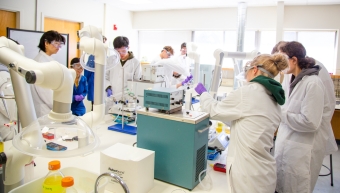
A new Chemical Engineering Department teaching laboratory, called the Asbury Pathfinder Lab, is home to a novel quarter-long course, ChemE 5: Introduction to Chemical Engineering Design, which gives freshmen students and others the chance to become familiar with the discipline through an immersive hands-on experience. The lab was made possible by an endowment from chemical engineering alumnus Douglas Asbury (’82).
ChemE 5 grew out of a seminar course (ChE 1A) that was introduced in 2016 as an orientation to chemical engineering. Joe Chada, the department’s first tenure-track teaching professor, recalls that when he arrived in 2018, “The department realized that students were getting to their sophomore year without knowing what chemical engineering is really about. They were just listening to seminars from faculty within the department and a few local companies.”
In fact, the department’s curriculum did not include a lab course until the second half of a student’s junior year. Now there are two undergraduate labs, including the Robert G. Rinker Teaching Lab for juniors and seniors, which Chada manages as well. Regarding ChemE 5, he says, “We thought it would be better to have a hands-on course much earlier to prepare and excite them for their sophomore-level courses by learning some fundamental chemical-engineering concepts and gaining a sense of the kinds of calculations they would do in the discipline.”
Chada, who received the UCSB Academic Senate’s Distinguished Teaching Award for 2022-’23 and describes the facility as a “hybrid lab and teaching space,” designed a biodiesel laboratory experience for the course. It exposes students to industrially relevant situations and processes, and provides hands-on training on modern equipment. Four teams of three students at a time can occupy the lab’s individual work stations, each of which is equipped with a benchtop reactor and fume hood.
The course fills an important gap. “When students are just starting out as freshmen in engineering or some other STEM discipline, they can’t yet visualize the different pieces of equipment or the processes they’re used for, so we need to show them,” Chada says. “The intention with this course is for students to be able to come into it not knowing what our discipline is and to try it out and then make a more informed decision as to whether they’d like to keep going. It’s not an easy course, but it’s also not meant to be extremely rigorous. It strikes a balance between being welcoming and authentic."
“I wanted the lab to be about addressing authentic problems,” he continues. “It’s challenging, and the students have a lot of deliverables to complete, but we’re there to support them, and the class doesn’t require a lengthy lab write-up. It’s you as a student doing real experiments to see how it feels to be an engineer.”
Once students have been trained on the equipment and learned safety protocols for the lab, they get to the engineering. “At the beginning of the course, we talk about how we need to switch our energy and emission landscape, and we suggest that biodiesel is one of many potential avenues to explore.” To that end, the students run a transesterification reaction to turn vegetable oil and alcohol — they use ethanol in the lab — into biodiesel and glycerol, then separate the biodiesel, the glycerol, and the ethanol. The ethanol is recycled for use in future courses. The glycerol is considered a waste product that a real processor would have to pay to discard or burn, so instead, the students run a saponification reaction to make customized bars of soap from it. The crowning achievement is using the biodiesel to run a small Stirling engine.
“Because it’s not a large-enrollment course, we have a lot of flexibility in our instruction,” Chada says. “Students are learning procedures and equipment, and there’s down time during many of the heating or cooling steps when we can demonstrate other processes and equipment that they’ll see later in the ChemE curriculum, so they get to connect some dots. We bring in equipment from research labs to demonstrate the exciting stuff that happens on campus and how their experiments relate to current research trends.” Currently the class runs in spring and fall quarter, and there is space for more students, Chada notes, saying that he can accommodate 72 students in up to six sections per quarter.
This story appeared in the Fall 2023 issue of Convergence, the College of Engineering's magazine.



